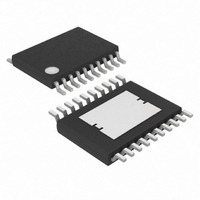MAX16834AUP+T Maxim Integrated Products, MAX16834AUP+T Datasheet - Page 16

MAX16834AUP+T
Manufacturer Part Number
MAX16834AUP+T
Description
IC LED DRVR HIGH BRIGHT 20-TSSOP
Manufacturer
Maxim Integrated Products
Type
HBLED Driverr
Datasheet
1.MAX16834ATP.pdf
(23 pages)
Specifications of MAX16834AUP+T
Topology
PWM, SEPIC, Step-Down (Buck), Step-Up (Boost)
Number Of Outputs
1
Internal Driver
No
Type - Primary
Automotive, Backlight
Type - Secondary
High Brightness LED (HBLED), RGB
Frequency
100kHz ~ 1MHz
Voltage - Supply
4.75 V ~ 28 V
Mounting Type
Surface Mount
Package / Case
20-TSSOP Exposed Pad, 20-eTSSOP, 20-HTSSOP
Operating Temperature
-40°C ~ 125°C
Internal Switch(s)
Yes
Lead Free Status / RoHS Status
Lead free / RoHS Compliant
Voltage - Output
-
Current - Output / Channel
-
Efficiency
-
Lead Free Status / Rohs Status
Details
High-Power LED Driver with Integrated High-Side LED
Current Sense and PWM Dimming MOSFET Driver
Boost configuration:
Boost-buck configuration:
where R
of voltage with current) of the LED string at the operat-
ing current, R10 is the LED current-sense resistor in
ohms, V
The output pole frequency for both boost and boost-
buck configurations is calculated as follows:
where f
tance in farads, R
in ohms calculated above.
Compensation components R7 and C7 perform two
functions. C7 introduces a low-frequency pole that
introduces a -20dB/decade slope into the loop gain. R7
flattens the gain of the error amplifier for frequencies
above the zero formed by R7 and C7. For compensa-
tion, this zero is placed at the output pole frequency f
such that it provides a -20dB/decade slope for frequen-
cies above f
The value of R7 needed to fix the total loop gain at f
such that the total loop gain crosses 0dB at
-20dB/decade at one-fifth of the RHP zero can be cal-
culated as follows:
where R7 is the compensation resistor in ohms, f
and f
resistor in ohms, R10 is the LED current-sense resistor
in ohms, factor 9.9 is the gain of the LED current ampli-
fier, and GM
amplifier in Siemens.
The value of C7 can be calculated as:
16
R
7
______________________________________________________________________________________
P2
R
=
P2
OUT
LED
LED
are in hertz, R8 is the switch current-sense
5
R
is in hertz, C
×
OUT
P2
is in volts, and I
f
=
is the dynamic impedance (rate of change
COMP
P
2
for the complete loop gain.
f
(
P
× −
R
=
2
(
LED
OUT
1
=
is the transconductance of the error
(
R
D
2π
LED
+
is the effective output impedance
MAX
(
(
R
R
R
f
OUT
ZRHP
10
×
LED
LED
+
C
)
)
R
×
LED
OUT
×
10
+
+
R
is the output filter capaci-
I
×
10 9 9
LED
1
R
R
)
R
10
10
is in amperes.
×
×
8
×
I
)
)
R
LED
×
×
×
.
OUT
D
V
V
MAX
×
LED
LED
+
GM
V
LED
+
COMP
V
L L ED
ZRHP
P2
P2
where C7 is in farads, f
To minimize switching frequency noise, an additional
capacitor can be added in parallel with the series com-
bination of R7 and C7. The pole from this capacitor and
R7 must be a decade higher than the loop crossover
frequency.
In the boost configuration (Figure 2), if the LED string is
shorted then the excess current flowing in the LED cur-
rent-sense resistor will cause NDRV to stop switching.
The input voltage will appear on the output capacitor,
and this causes very high peak currents to flow in the
LED current-sense resistor R10 because the dimming
MOSFET (Q2) is on. Once the voltage across the LED
current-sense resistor exceeds 300mV for more than
5μs, then the dimming MOSFET Q2 turns off and stays
off for 4096 switching clock cycles. At the same time,
NDRV is also off. The MAX16834 goes into the hiccup
mode and recovers from hiccup once the short has
been removed. The power dissipation in the dimming
MOSFET (Q2) is minimized during a short across the
LED string. During the same period, FLT only goes high
when the dimming MOSFET is on.
In the case of the boost-buck configuration (Figure 3),
once an LED string short occurs then the behavior is
different. A short across the LED string causes a high
current spike due to the external capacitors at the out-
put. The regulation loop will cause NDRV to stop
switching. This causes the voltage on HV to drop if its
voltage is derived from LED+. The voltage on CLV will
drop, and this drop is detected after 128 clock cycles.
The dimming MOSFET and the switching MOSFET will
stop switching. It stays off for 4096 clock cycles, and
the cycle repeats itself. The short across the LED string
will cause the MAX16834 to go into a hiccup mode. At
the same time the FLT signal asserts itself for 4096
clock cycles every hiccup cycle. In the case where the
HV voltage is derived from a source different than
LED+, then the LED current will stay in regulation even
during a short across the LED string. In this case, FLT
does not assert itself during the short.
C
7
=
P2
2π
Short-Circuit Protection
is in hertz, and R7 is in ohms.
×
Boost-Buck Configuration
R
1
7
×
f
Boost Configuration
P
2












